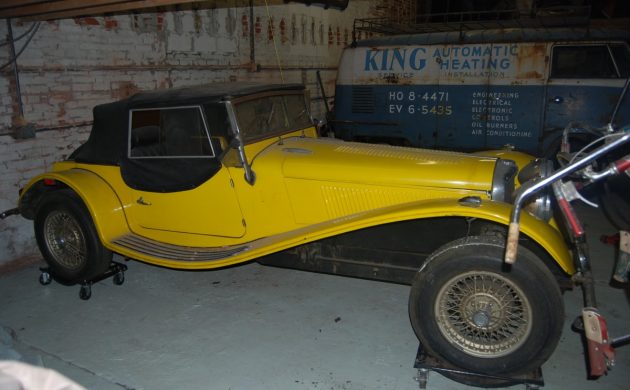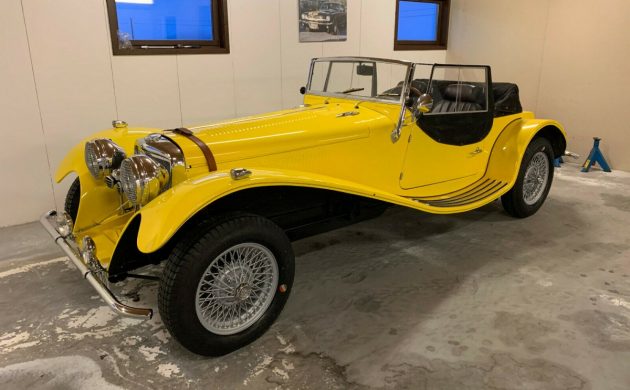Prototype Revisited: 1972 Intermeccanica Squire SS100
Here at Barn Finds, not only do we love to see and write about the hidden gems that people find that have been squirreled away for years, but occasionally, we also have the privilege of writing about these cars once they have been returned to their former glory. This is not the first time that we’ve seen this 1972 Intermeccanica Squire SS100 prototype, as our illustrious Josh Mortensen revealed the classic in 2012 in this excellent article. In fact, this first photo is from that article, and clearly shows the condition of the car when it was unearthed. The Squire has now been revived and is looking for a new home. It is located in Brattvaag, Norway, and has been listed for sale here on eBay. Bidding has now reached $27,000, but the reserve hasn’t been met. There is also a BIN option, and this has been set at $42,000.
It’s amazing the difference a few years, combined with dedication and hard work, can make to a classic car. The owner refers to this as more of a repairing process than a restoration project. The vehicle has been treated to a fresh coat of its original yellow paint, while every piece of external trim and chrome has been meticulously refurbished, and the Dunlop 72-spoke wheels have been restored. Interestingly, when the refurbishment process was underway, the owner discovered that the fiberglass panels on the right-hand side of the vehicle had actually originally been painted red. While there is no concrete explanation for this, it is entirely possible that Intermeccanica was experimenting with colors on the car before settling on the three regular shades (Yellow, Red, and White) that the Squire eventually became available in. This particular car possesses a number of unique or rare features that differentiate it from the regular production versions. The first and most obvious is that it was the only example that was built with a fold-down windshield, because the windshields on the production models were fixed. Similarly, the prototype Squire was one of the few vehicles that featured four rubbing strips on the running boards. The vast majority of regular production Squires featured three strips. Having said that, there were a few of the production versions (10) that carried this feature. Overall, the refurbishment has left this car looking quite stunning, with not a flaw visible on the Squire’s exterior.
Essentially, the interior of the Squire prototype was identical to the production versions, indicating the Intermeccanica hit upon their combination for this area of the car pretty quickly. Upholstered surfaces were all originally trimmed in Black leatherette, and while the dash didn’t have the luxurious appearance of the Jaguar upon which the Squire was based, it still looked neat and tidy nonetheless. The interior of this car has been nicely refurbished, and once again, there is little to fault. One thing that I really like is the fact that while the current owner has put so much effort into his work, he has chosen to leave the spokes on the wheel as-found. This is a great touch that provides an insight into the car’s age and history.
Motive power for the Squire SS100 was derived from Ford components, with a 250ci 6-cylinder engine sending its power to a Ford 9″ rear end via either a 4-speed Top Loader, or in this case, a C4 automatic transmission. In keeping with the pure feel of the sports car, there was no power assistance available for the steering, or for the 4-wheel Bendix drum brakes. The drive-train of this vehicle was removed during the refurbishment, and everything was checked for good mechanical health, then detailed, and returned to its rightful place. The Squire was built in Italy exclusively for the American market, under a contract with Auto Sport Importers Inc, of Philadelphia, Pennsylvania. The initial intention was to build at least 100 cars, and to this end, 100 complete Ford drive-trains were purchased and shipped to Italy. As one historian diplomatically put it, during the trip from the US to the Intermeccanica manufacturing facility, “there was a severe shrinkage of this inventory.” In the end, it was probably a good thing that the build only came to a total of 50 cars because while all were built during 1972 and 1973, the last of the new vehicles didn’t find themselves a home until 1975. The survival rate for the Squire has actually been quite astonishing, because of those 50 original cars, there are currently 44 still plying the roads today. One interesting point is that while this car is definitely and confirmed as the prototype, it was assigned Serial Number 15 out of those 50. Today, the register shows the prototype as separate from the sequential serial numbers, but it shows the status of number 15 listed as “missing.”
There are people today who will look at the Intermeccanica Squire SS 100 and draw the mistaken belief that it is a kit car. To do this is to be doing the car a grave disservice, as it truly is a hand-built Italian sports car. This one is beautifully presented, and given the fact that it has been confirmed as the prototype, that makes it special amongst a small group of exclusive cars. The chance to purchase a prototype doesn’t occur terribly often, and I hope that someone buys it who will be willing to drive and appreciate it. I would hate to think that it will finish up back in storage again because that’s a fate that it simply doesn’t deserve.
Auctions Ending Soon
 2006 Ford Mustang Saleen S281 SCBid Now17 hours$15,000
2006 Ford Mustang Saleen S281 SCBid Now17 hours$15,000
 2002 Subaru Impreza WRXBid Now3 days$333
2002 Subaru Impreza WRXBid Now3 days$333
 1975 Chevrolet Corvette ConvertibleBid Now3 days$3,000
1975 Chevrolet Corvette ConvertibleBid Now3 days$3,000
 1964 Ford F-100 Camper CustomBid Now3 days$2,000
1964 Ford F-100 Camper CustomBid Now3 days$2,000
 2006 Jeep Wrangler SportBid Now5 days$10,500
2006 Jeep Wrangler SportBid Now5 days$10,500






Comments
Looks a lot like a Panther J72. Most will think it’s just another kit car and be looking for the engine in the back. I like it.
Why not a Jag six under the bonnet????
Pinto in cat’s clothing. Hate to see that boring Ford sourced automatic sticking up through the tunnel.
Just below the picture of the engine compartment. “250 ci 6 cyl engine”. Not a Pinto 4 cyl.
Maverick/Mustang/Granada in cat’s clothing. :)
Still don’t like the look of that T handle sticking up through the floor of this otherwise striking automobile.
The Ford 250 i6 had the awful intake log that is part of the head casting. It is not an easy engine to juice up… a cheapo engine in an otherwise lovely body.
Won’t disagree regarding the choice of the 250 I6. They can be built, but doing so rapidly becomes expensive enough to say “Why bother???”.
Also, along with about everyone that frequents this board, IMHO, automatics really don’t belong in sports cars. You want a sports car, learn to drive a stick. Added benefit, the periodic news stories that I see where a car theft/carjacking is thwarted because the thief didn’t know how to drive a stick.
yes, they were a rare short production sports car. i worked on a few of them in my shop, for ed felbin, in phila, pa.
i did work on, i think, #1, and #2. we had to update them for the american market.
Hi there, the #1 prototype was my grandfather’s personal car. Did you know Michael by any chance?